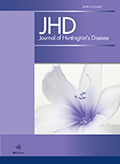Authors: Latimer, Caitlin S. | Flanagan, Margaret E. | Cimino, Patrick J. | Jayadev, Suman | Davis, Marie | Hoffer, Zachary S. | Montine, Thomas J. | Gonzalez-Cuyar, Luis F. | Bird, Thomas D. | Keene, C. Dirk
Article Type:
Research Article
Abstract:
Background: Huntington’s disease (HD) is an autosomal dominant neurodegenerative disease caused by a trinucleotide (CAG) repeat expansion in huntingtin (HTT ) on chromosome 4. Anticipation can cause longer repeat expansions in children of HD patients. Juvenile Huntington’s disease (JHD), defined as HD arising before age 20, accounts for 5–10% of HD cases, with cases arising in the first decade accounting for approximately 1%. Clinically, JHD differs from the predominately choreiform adult onset Huntington’s disease (AOHD) with variable presentations, including symptoms such as myoclonus, seizures, Parkinsonism, and cognitive decline. Objective: The neuropathologic changes of AOHD are well characterized,
…but there are fewer reports that describe the neuropathology of JHD. Here we report a case of a six-year-old boy with paternally-inherited JHD caused by 169 CAG trinucleotide repeats who presented at age four with developmental delay, dysarthria, and seizures before dying at age 6. The boy’s clinical presentation and neuropathological findings are directly compared to those of his father, who presented with AOHD and 54 repeats. Methods: A full autopsy was performed for the JHD case and a brain-only autopsy was performed for the AOHD case. Histochemically- and immunohistochemically-stained slides were prepared from formalin-fixed, paraffin-embedded tissue sections. Results: Both cases had neuropathology corresponding to Vonsattel grade 3. The boy also had cerebellar atrophy with huntingtin-positive inclusions in the cerebellum, findings not present in the father. Conclusions: Autopsies of father and son provide a unique opportunity to compare and contrast the neuropathologic findings of juvenile and adult onset HD while also providing the first immunohistochemical evidence of cerebellar involvement in JHD. Additionally this is the first known report to include findings from peripheral tissue in a case of JHD.
Show more
Keywords: Autopsy, huntingtin protein, Huntington’s disease, immunohistochemistry, juvenile Huntington’s disease, literature review, neuropathology
DOI: 10.3233/JHD-170261
Citation: Journal of Huntington's Disease,
vol. 6, no. 4, pp. 337-348, 2017
Price: EUR 27.50




